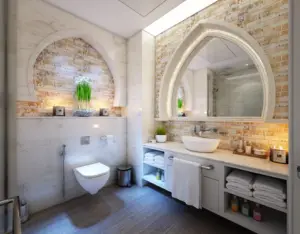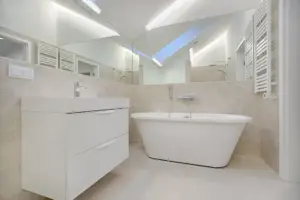By George House/14,July,2025
Barn doors are wide, flat doors which, as the name suggests, can be found on farms, but now they are also adding appeal to homes. Unlike swing doors which are cumbersome and need generous space to open and close freely, barn door slide beside the wall which makes them handy in cramped places.
However, getting a door that is lasting and also aesthetically appealing requires the consideration of the wood type quite closely. That’s why, this guide will tell you the different types of woods available so that you can make a better selection.

1) Understanding Barn Doors
A barn is a large farm building used for storing crops, farming equipment, or livestock. They have large entrances , and hence farmers need strong doors for protection. That’s where a barn door come into play. Barn doors are big flat doors that slide open rather than swinging.
While barn doors once were restricted to farms, their use has expanded greatly in recent years with indoor installations. This is mostly due to their aesthetic value as well as their space conserving feature.

➔ Types of barn doors
- A single barn door will only open to one side.
- A double barn door opens from the center.
- A Bypass barn door slides past each other, which is great for closets.
- Styles like Z-pattern and X-pattern can also be chosen to give it a classic rustic look.
➔ Why Wood is most popular in Barn Door’s Construction?
The type of wood used in a barn door determines its strength, structural integrity, and longevity. These attributes are dependent on the wood’s moisture reaction, density, and grain pattern. Stable structural components limit warping ( change in shape because of moisture retention ), which enables smooth functioning over time.
Besides its aesthetic value, wood also provides insulation against heat and sound. Furthermore, its organic patterns and textures add to its attractiveness making every door unique. In addition, wooden parts can easily be altered, fixed, or recycled when compared to other materials.
Functionally and visually, wood proves to be an ideal choice owing to all the previously mentioned characteristics. Now! A question arises that how can we choose the best wood type for barn doors. Well! We’ll answer this in later sections.
2) Best Wood for Barn Doors: Exploring wood types
As we discussed earlier that wood is the most popular choice for bar doors. However, there are different types of wood that exist in nature each having different properties. So, lets have a look at these types, so you’ll choose the best wood type barn door!
i) Pine
Pine falls into the softwood category, derived from conifer trees. It has low density, as well as an even, straight grain ( lines and patterns showing on the surface of wood).

- Key Features:
Pine’s lower density makes it easy to lift and install. Additionally, it is simple to cut, painted, and shaped. Because it takes up color well, it works for imaginative designs. Unfortunately, pine being soft means that it easily gets scratched and dented. This makes it suitable only for indoor doors.
ii) Cedar
Cedar is known for its natural oils (Thujaplicin + phenol) which are used to resist moisture, mold and insects. In addition, it is a softwood with a medium density and a straight grain.

- Key Features:
Warm reddish hue and fragrant smell helps to identify cedar. Also, its water resistance helps retain strength outdoors, along with light weight and durability, especially in damp and ever changing weather.
Because of these characteristics, cedar is the ideal choice for outdoor barn doors or spaces prone to high moisture conditions.
iii) Oak (Red & White)
Oak is a hardwood which is high in density, with a coarse grain, and is very strong. It also contains tannin which resist fungal attacks.

- Key Features:
From all wood types, oak is one of the most durable. It bestows a rustic, natural look to your door because of its pronounced grain. Once fitted, it bears decades of active use without any signs of failing, breakage, or bending. This makes oak ideal in heavily trafficked areas, making it suitable for larger and sturdier doors.
iv) Alder
Alder is classified as a soft hardwood. It has low to medium density, but evenly and polished grained.

- Key Features:
People looking for warm and rich tones will have no trouble finding it in alder. Its softer nature will not be an issue, as it takes stain evenly and smoothing out the finish.
For those worried about staying under their budget, alder’s lower price is a definite plus, allowing for beauty without breaking the bank. As such, softer hardwoods can also serve as indoor doors that are elegant.
v) Maple
Maple is an impact resistant finely grained hardwoods. Also, it doesn’t contain high amount of extract, thus it has pale appearance.

- Key Features:
Maple is the stronger wood and lasts long too. Also, its tight grain and chemical makeup makes its surface smooth which makes painting your door easy. Moreover, it doesn’t get dents easily so homes with kids and pets are recommended to use it. It’s strong enough for heavily used areas. With maple, you get both a clean look and function.
vi) Walnut
Walnut is classified as hardwood having a medium density, closed grain, and dark color. It also possesses shock resistance as well as dimensional stability.

- Key Features:
Walnut is greatly admired for its deep and rich color. Designers often use walnut for feature or high-end doors. It does not shape-shift easily and does not age. If you want your barn door bold design piece, walnut is the way to go.
vii) Reclaimed Wood
Reclaimed wood comes from old buildings, barns, and factories, which are referred to as recycled wood. It has weathered characteristics as well as age which are attributes to its species.

- Key Features:
Reclaimed wood comes with a story and is beautiful in its own right. It has unique aging marks and shifting grain patterns. Though this wood requires additional cleaning and sealing before installation, the results make the effort worthwhile.
If you appreciate vintage or rustic aesthetics, this style instantly modernizes a home while incorporating a natural historical charm.
viii) Douglas Fir
Because Douglas Fir is a softwood with medium to high strength and an impressive strength-to-weight ratio.

- Key Features:
Most notably, this wood provides reliable durability so large barn doors can be constructed easily. It is also attractive due to its smooth and straight grain. The doors will remain flat and smooth after many years because the wood resists distortion and warping. This wood is ideal for custom builds and wider openings.
- Comparison table
| Durability | Cost | Aesthetic appeal | Best for | |
| Pine | Moderate | Low | Simple, paintable | Interior budget door |
| Cedar | Good | Medium | Rustic, aromatic | Outdoor use |
| Oak | Excellent | Medium–High | Bold, rustic | High-traffic areas |
| Alder | Good | Medium | Soft, warm look | Stained interior doors |
| Maple | Very High | Medium–High | Clean, smooth | Painted, durable interiors |
| Walnut | Excellent | High | Rich, premium feel | Statement pieces |
| Reclaimed wood | Varies | Medium–High | Vintage, full of texture | Eco-conscious designs |
| Douglas fir | Good | Medium | Natural, straight grain | Large sliding doors |
3) Factors to Consider When Choosing Wood for barn doors
Choosing the type of wood for your barn door requires thoughtful selection because it relates to the maintenance needs of the wood.
Indoor vs Outdoor use: If the barn door has to be used outdoors, it will need protection from rain, sunlight, and shifting temperatures. Woods for such locations would require rot resistant properties. On the other hand, softer woods can be used for doors indoors since they do not have to face weather exposure.
Personal Preferences and Design: Moreover, the architectural style also defines how the wood will look. For farmhouse or rustic designs, wood that has striking visible grains works best.
But for modern minimalistic designs, smoother wood which is easier to paint is preferred. It’s texture and structure will dictate how it will accept paint or stain.
Durability and Maintenance: Woods are best for the described purposes that are made from oils or tannin-rich materials because such woods are resistant to pests. Some wood types have simple care demands which will be beneficial for long term low upkeep burden.
Weight and Functionality: In addition, stronger woods demand heavier tracks and supports, while lighter woods ease pressure on your walls and slide more easily. Thus, density and grain determine weight.
Budget: Last but not least, hardwood is the most expensive wood since it is stronger and lasts longer. While softwoods are cheaper and easier to work with, making them a great choice for indoor use.
4) Final Words
All in all, in choosing the correct wood for a barn door, one needs to consider its sturdiness, elegance, and durability. Having some knowledge regarding wood types already enables you to pick one that suits your taste and needs.
You can visit George Group which offers beautifully crafted and well designed options. Our products balance between functionality and improving the overall visual appeal of the area. So, reach out today!





